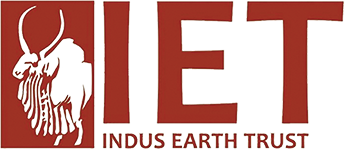Introduction
Indus Earth Trust (IET) has considerable experience in building using earth, stone and bamboo as materials to build secure and resilient houses. The structures built have survived several years of heavy rain, strong winds and are earthquake resistant.
Training in this specific technique was undertaken by Shahid Khan (Architect, Founder and Chief Technical Advisor to Indus Earth Trust) at CRATerre, France and Tokyo University. Japan; the latter being in Earth Quake Resistant techniques using indigenous construction systems.
By designing shelters using local materials and training communities in proper construction methods, Indus Earth Trust can equip villagers with tools for long term sustainable shelters. Indus Earth Trust helps protect the key assets of family and income such as animals and poultry, as they are essential for development and poverty alleviation.
Unexpected weather patterns and extreme precipitation due to climate change have destroyed shelters for humans and animals. There is a need to readjust thinking in the methodology of building systems. To that end IET has re-evaluated indigenous building systems with contemporary knowledge local materials: namely earth, bamboo and stone.There is a need to adapt current construction techniques and types taking all these factors into account.
Indus Earth Trust partnered with CRATerre, the world leaders in earth housing. Together they built a training center in Gharo which demonstrated various techniques such as Adobe, Cob, Wattle and Daub, Compressed Earth Blocks (CEB), Rammed Earth methods. Indus Earth Trust and CRATerre also trained masons and carpenters to build earthquake resistant houses using salvaged material from the earthquake destroyed houses in Bagh, Azad Kashmir.
Indus Earth Trust believes in lifting populations out of poverty and development with dignity. IET trains masons and carpenters to build specifically designed structures. This enables them to build their own houses and start their own business in building for others.
Objectives
- Targeting SDGs; 1) No Poverty, 12) Responsible Consumption & Production 13) Climate Action
- Providing safe adequate and affordable housing with a zero carbon footprint.
- Reduce economic loss due to disaster to infrastructure and disruption of basic services
- Provide basic needs such as shelter which reduces pressure on urban settlements and encourages communities to live in their native environments
- Providing technical expertise in building resilient and sustainable structures using local materials with earthquake resistant formula
- Increasing livelihood
Benefits
- Providing trained masons and carpenters to enable them to start their businesses.
- Providing work for rural communities improving living standards
- Increase comfort of inhabitants by keeping the temperature cool in summer and warm in winter
- Indigenous housing materials is readily available and affordable by the rural population.
Program outreach
- Indus Earth Trust has constructed over 50 using Adobe and Bamboo structures in Awaran District of Baluchistan,
- 3 Earthquake resistant houses in Bagh, Azad Kashmir with CRATerre engineers.
- Reconstructed 84 adobe, wattle and Daub and bamboo shelter houses that were affected by the floods in 2010 in Sujawal Union Council
- An extensive programme was undertaken in Jallal Khan village Sibi. Balochistan in providing flood resistant housing there. Several shelters were built and are perfectly protected from the recent floods.
- Trained more than 20 masons and carpenters. Each mason then trains two apprentices who help them build a house
Adobe shelters
Adobe structures are extremely durable, stays cool in hot climates and warmth in the winter. This is a well tried technique throughout Pakistan.
Compressed Earth Block
Compressed Earth Block construction material formed in a mechanical press that makes an appropriate mix of dirt, non-expansive clay, and an aggregate into a compressed block. Each block gas a psi of 1800-2000.
Bamboo Shelters
Bamboo is an excellent replacement for the use of timber which is a depleting source in our country. It has a tensile strength greater than steel and is used from making simple baskets to major construction.
Cob Shelters
Cob is an indigenous building material consisting of clay, sand, straw, water and earth, similar to adobe. Cob is fireproof, resistant to seismic activity, and inexpensive. It has been revived in recent years by the natural building and sustainability movements.
Rammed Earth
Ability to with stand the unpredictable weather conditions and extreme climate changes that are occurring. A prayer place is built at the Mehran Human and Institutional Development Center.











